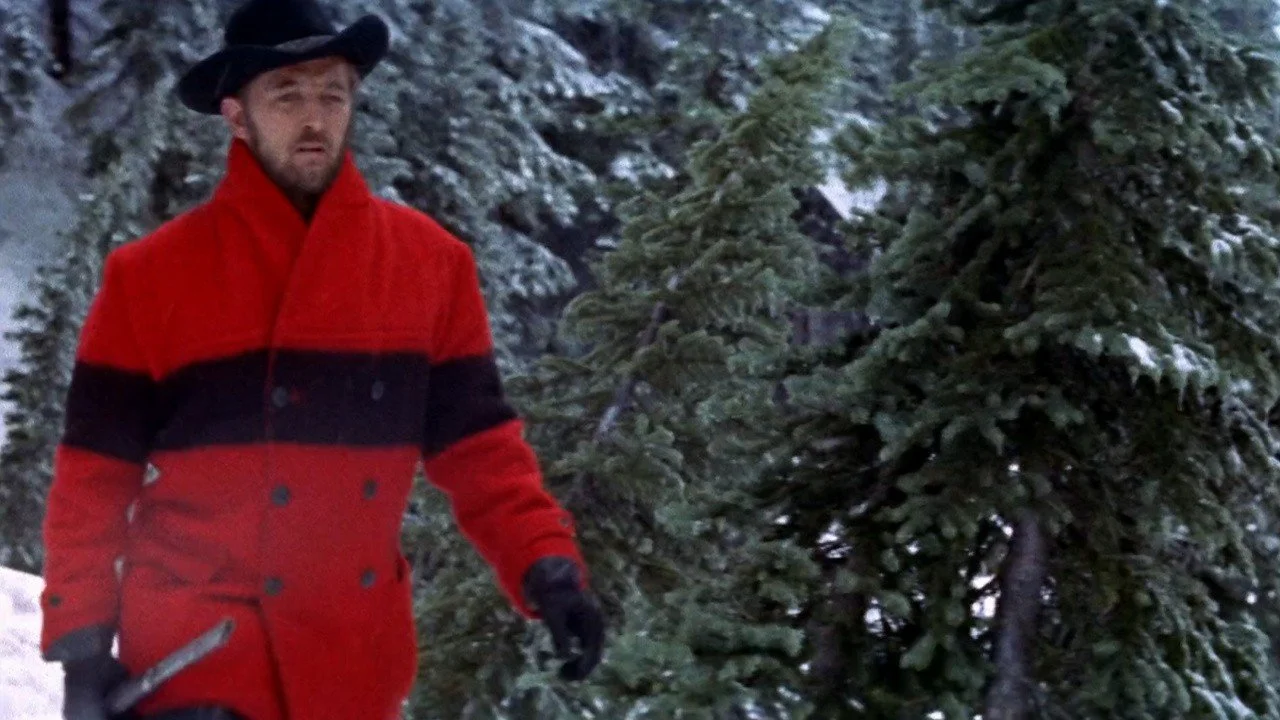Track of the Cat Film Review
The birth order theory holds that the middle child is the family peacekeeper and team player. Robert Mitchum’s character in “Track of the Cat” (1954) is the exact opposite; a narcissistic bully who exudes toxic masculinity. Mitchum plays Curt, the second of three sons in the Bridges family. Curt’s fragile sense of self can only be maintained by emasculating his brothers and supplanting his father as head of the household. His sister Grace (Teresa Wright) attempts to challenge his dominance but is denigrated for her spinsterhood and piety.
Curt Bridges (Robert Mitchum) hunts the elusive black panther. His distinctive red jacket is one of the few pops of color in the film.
Curt’s mother Letty (Beulah Bondi) is his staunchest ally. When her eldest son Art (William Hopper) is killed by the black panther referenced in the film’s title, Letty reflects on the ramifications of her actions. “It was always Curt and me against him [Art]. The rest of you let him fight your battles for you,” she laments. Letty’s principal crusade, preventing any “outsider” from gaining influence in the family, partially explains why her four adult children are still single and living with their parents. She views any expansion of the family as a betrayal, both emotional and financial.
What incites her wrath in the film’s opening act is the arrival of Gwen (Diana Lynn), whom her youngest son Hal (Tab Hunter) hopes to marry. While Art defends Hal’s right to wed and receive a share of the ranch, Letty is adamantly opposed. “Once the splitting starts, it never ends,” she opines. Curt, of course, is in complete agreement with his mother. He has his own ideas about what is best for Gwen. The up-and-down look Curt aims her way makes it clear that indoors, Curt is the predator to be feared.
Grace (Teresa Wright) pleads with her younger brother, Hal (Tab Hunter) to assert his independence in William Wellman’s psychological Western.
“Track of the Cat” was directed by William Wellman, who began his career in the silent film era. It is puzzling that he chose to overload this film with dialogue rather than let Mitchum’s physical eloquence speak for itself. Screenwriter A.I. Bezzerides, adapting Walter Van Tilburg Clark’s novel, fully expected Wellman to make cuts to his first draft screenplay. He was reportedly stunned when that didn’t happen.
As a result, according to Mitchum biographer and critic Lee Server, “Track of the Cat” suffers from a “shallow pretentiousness” that contrasts with the film’s visual beauty. My take is that the approach is heavy-handed rather than shallow. If half the dialogue had been cut, viewers would still intuit the meaning and the interior scenes would not register as a filmed play. Wellman’s visual acuity is apparent, however, in the ironic display of a first commandment plaque in the Bridges’ kitchen.
The panther as a symbol for “all the evil in the world” is explicitly stated in dialogue given to Curt. It is more accurate, however, to narrow the focus and view the panther as an emblem of greed, expansionism, and settler colonialism in America. The family has a Native American servant, Joe Sam (unfortunately played by Carl “Alfalfa” Switzer in heavy makeup). Ma Bridges refers to him as a “no-good Indian” while Curt physically abuses him. Hal, explaining Joe Sam’s story to Gwen, references the land theft and internal migration forced on Indigenous peoples. Moreover, the black panther kills Joe Sam’s wife and daughter. The panther continuing his murderous rampage with the deaths of Art and Curt could be interpretated as a warning against the self-destructive practices of capitalism and materialistic families such as the Bridges.
The film’s ending is foreshadowed in the opening scene when Curt calls Hal “the white hope of the Bridges.” At its core a coming-of-age drama, “Track of the Cat” ends with Hal winning the girl and vanquishing the cat. Hal manages to synthesize his empathy with a newfound assertiveness. While the happy ending is unnatural, “Track of the Cat” is worth analyzing for its depiction of an American family in distress.
Content copyright © 2025 by Angela K. Peterson. All rights reserved. This content was written by Angela K. Peterson. If you wish to use this content in any manner, you need written permission.


